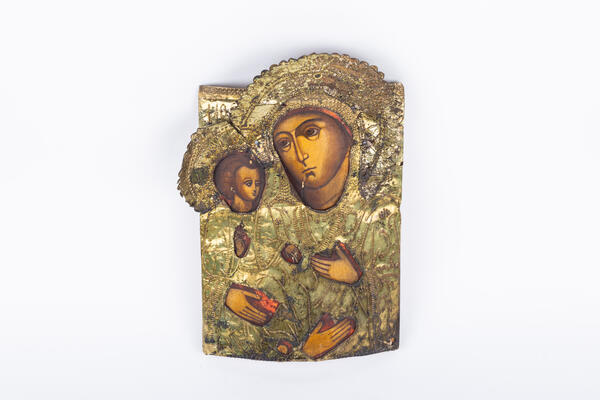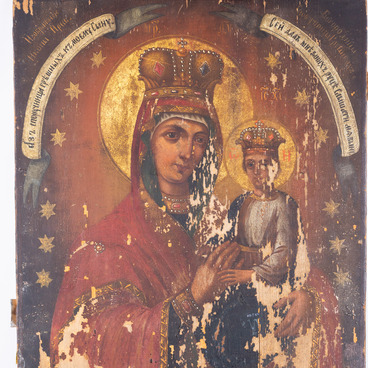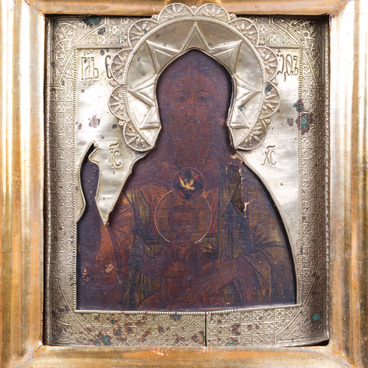PanagIa TricherOUsa, also known as TrojerUčica, is revered by Christians around the world. What makes this icon unique is the extra hand in the lower corner.
The history of this holy image goes back to the times of Saint John of Damascus, a prominent theologian, philosopher, and hymn writer. The 8th century Byzantium experienced a surge of iconoclasm, spearheaded by Emperor Leo III the Isaurian himself. Legend has it that John of Damascus, known for his ‘tongue of gold, ’ responded to this by writing three treatises in defense of icon veneration and sending them to the Emperor. While enraged, Leo found himself unable to punish John: the philosopher was an advisor at the source of the Caliph of Damascus, and therefore not his subject.
So he devised a cunning plan. He had his minions forge a letter, making it look like John was conspiring with the Byzantine Emperor, with plans to attack Damascus and invade the entire Caliphate. The Caliph, believing the letter to be genuine, banished John from his court. More than that, he ordered to have the philosopher’s right hand cut off and paraded around the city square.
Some time afterwards, the severed hand was given back to the imprisoned John. He placed the dead limb against his wrist stump and began praying fervently before the icon of Mary, asking Her to heal him. The Mother of God came to him in his dreams that night, promising to answer his pleas. When the saint awoke, he discovered that his hand and wrist stump had miraculously fused, and he could use his fingers again.
He expressed his gratitude by adding a third hand to the image of Mary, cast in silver. Afterwards, as icon painters began to copy the image, they kept including all three hands. And thus, a whole new depiction of Mary emerged: Panagia Tricherousa. Saint John of Damascus is also the author of a hymn called “In Thee Rejoices…”:
“O Blessed Mary, in Thee rejoices every creature, and the Host of Angels, and all Humankind. For Thou art a sacred temple, and a paradise of spirit, and the glory of virginity, from whence came our Lord, He that existed before all ages, and became the Divine Infant. For He turned Thy loins into the Holy Seat, and made Thy womb wider than the Heavens. O Blessed Mary, in Thee rejoices every creature; praise be!”
The central part of the icon shows the Child Christ in His Mother’s arms. He is making a gesture that shows that He is giving His blessing to any people facing the icon. Mary, in turn, is pointing at Her Son, showing that He is humankind’s key to salvation. The third hand—the hand of John of Damascus—is a symbol of Mary’s blessing and compassion bestowed upon all people in need.
The history of this holy image goes back to the times of Saint John of Damascus, a prominent theologian, philosopher, and hymn writer. The 8th century Byzantium experienced a surge of iconoclasm, spearheaded by Emperor Leo III the Isaurian himself. Legend has it that John of Damascus, known for his ‘tongue of gold, ’ responded to this by writing three treatises in defense of icon veneration and sending them to the Emperor. While enraged, Leo found himself unable to punish John: the philosopher was an advisor at the source of the Caliph of Damascus, and therefore not his subject.
So he devised a cunning plan. He had his minions forge a letter, making it look like John was conspiring with the Byzantine Emperor, with plans to attack Damascus and invade the entire Caliphate. The Caliph, believing the letter to be genuine, banished John from his court. More than that, he ordered to have the philosopher’s right hand cut off and paraded around the city square.
Some time afterwards, the severed hand was given back to the imprisoned John. He placed the dead limb against his wrist stump and began praying fervently before the icon of Mary, asking Her to heal him. The Mother of God came to him in his dreams that night, promising to answer his pleas. When the saint awoke, he discovered that his hand and wrist stump had miraculously fused, and he could use his fingers again.
He expressed his gratitude by adding a third hand to the image of Mary, cast in silver. Afterwards, as icon painters began to copy the image, they kept including all three hands. And thus, a whole new depiction of Mary emerged: Panagia Tricherousa. Saint John of Damascus is also the author of a hymn called “In Thee Rejoices…”:
“O Blessed Mary, in Thee rejoices every creature, and the Host of Angels, and all Humankind. For Thou art a sacred temple, and a paradise of spirit, and the glory of virginity, from whence came our Lord, He that existed before all ages, and became the Divine Infant. For He turned Thy loins into the Holy Seat, and made Thy womb wider than the Heavens. O Blessed Mary, in Thee rejoices every creature; praise be!”
The central part of the icon shows the Child Christ in His Mother’s arms. He is making a gesture that shows that He is giving His blessing to any people facing the icon. Mary, in turn, is pointing at Her Son, showing that He is humankind’s key to salvation. The third hand—the hand of John of Damascus—is a symbol of Mary’s blessing and compassion bestowed upon all people in need.



